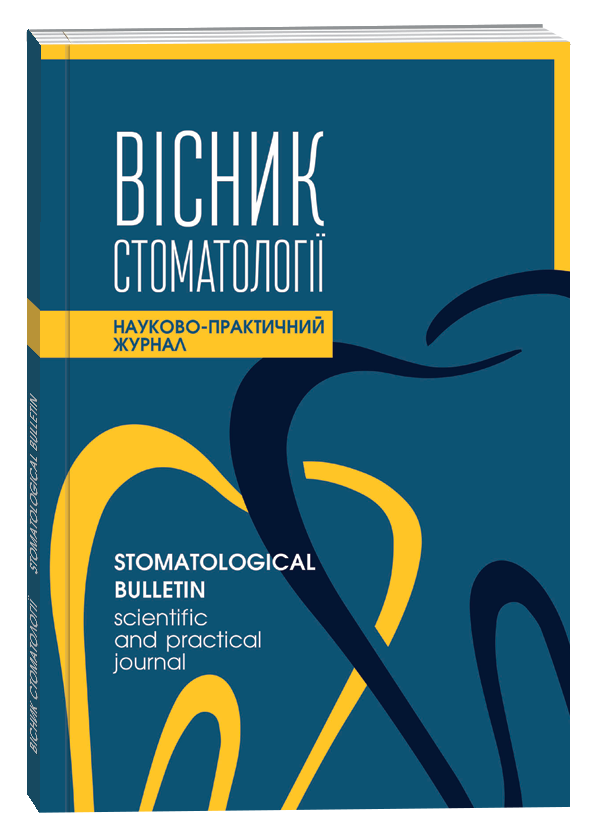DIGITAL DIAGNOSTICS IN THE TREATMENT OF MAXILLOFACIAL PATHOLOGY
DOI:
https://doi.org/10.35220/2078-8916-2022-45-3.10Keywords:
occlusion, anomalies of occlusion, preventive examination, orthodontic structures, orthopedic pathology.Abstract
The purpose of the study is to justify the feasibility of a comprehensive study of static and dynamic parameters of occlusion during the replacement of included dentition defects, as well as the dynamics of rehabilitation based on the analysis of Research methods To achieve the goal, the dental examination data with additional functional digital analysis of occlusion of 100 people (aged 25 to 60 years) were analyzed. All patients were divided into 3 groups. Group 1 included 10 people who had no objective or previously treated dental pathologies. The 2nd group included 45 patients with dentition defects within the limits of molars and premolars with replacement using stamped and soldered bridge prostheses. Group 3 included 45 patients who had dentition defects within molars and premolars without replacement of defects. An additional condition was the use of prostheses or lack of integrity of the dentition for a period of 1 to 2 years. In addition, functional diagnostic studies were carried out – digital analysis of occlusion (T-scan III Novus, USA). Materials of clinical and statistical research were subjected to variational and statistical processing according to the purpose of our work. The results of the research were processed using generally accepted methods of mathematical statistic. Scientific novelty With the help of modern methods, the objectivity and necessity of using digital methods of diagnosis and the development of new protocols for the rehabilitation of dental patients with secondary dentition have been clearly proven. Conclusions Taking into account the results of the analysis of the research data, we concluded that the quality of restoration of the function of the maxillofacial system according to the classical method is low. Thus, 45 patients who had secondary dentition with replacement had violations of occlusal relationships due to the lack of functional and quantitative control at the stage of restoring the integrity of the tooth rows and after the installation of restorative structures.
References
Dawson P. Functional occlusion from TMJ to smile design. / Peter E. Dawson. – MosbyElsevier. – St Louis.2006, 630.
Gümüş HÖ, Kilinç HI, Tuna SH. (2013). Computerized analysis of occlusal contacts in bruxism patients treated with occlusal splint therapy. J Adv Prosthodont, 5(3), 256–61.
Mar Prasad K, Swaminathan A, Prasad A. (2024). A review of current concepts in bruxism-diagnosis and management. Nitte University Journal of Health Science, 4(4):129, 43(3):205-14
Slavicek R. The masticatory organ Functions and disfunctions. / Rudolf Slavicek. –Klosterneuburg: Gamma med-wiss Forbidungs- AG. 2006, 544
Jeong, M. Y., Lim, Y. J., Kim, M. J., & Kwon, H. B. (2020). Comparison of two computerized occlusal analysis systems for indicating occlusal contacts. The journal of advanced prosthodontics, 12(2), 49–54. https:// doi.org/10.4047/jap.2020.12.2.49
Pacheco-Pereira C, Brandelli J, Flores-Mir C. (2018). Patient satisfaction and quality of life changes after Invisalign treatment. J Orthod Dentofacial Orthop, 153(6), 834-41.
Wetselaar, P., Lobbezoo, F., de Jong, P., Choudry, U., van Rooijen, J., & Langerak, R. (2020). A methodology for evaluating tooth wear monitoring using timed automata modelling. Journal of oral rehabilitation, 47(3), 353–360. https://doi.org/10.1111/joor.12908.
Wetselaar, P., Wetselaar-Glas, M., Katzer, L. D., & Ahlers, M. O. (2020). Diagnosing tooth wear, a new taxonomy based on the revised version of the Tooth Wear Evaluation System (TWES 2.0). Journal of oral rehabilitation, 47(6), 703–712. https://doi.org/10.1111/ joor.12972 9. Di Palma, E., Tepedino, M., Chimenti, C., Tartaglia, G. M., & Sforza, C. (2017). Longitudinal effects of rapid maxillary expansion on masticatory muscles activity. Journal of clinical and experimental dentistry, 9(5), e635–e640. https://doi.org/10.4317/ jced.53544
Mikami S., Yamaguchi, T., Saito, M. et al. (2022). Validity of clinical diagnostic criteria for sleep bruxism by comparison with a reference standard using masseteric electromyogram obtained with an ultraminiature electromyographic device. Sleep Biol. Rhythms. https:// doi.org/10.1007/s41105-021-00370-5
Ramsay, D. S., Rothen, M., Scott, J. M., Cunha- Cruz, J., & Northwest PRECEDENT network (2015). Tooth wear and the role of salivary measures in general practice patients. Clinical oral investigations, 19(1), 85–95. https://doi.org/10.1007/s00784-014-1223-4
Agbaje, J. O., Casteele, E. V., Salem, A. S., Anumendem, D., Shaheen, E., Sun, Y., & Politis, C. (2017). Assessment of occlusion with the T-Scan system in patients undergoing orthognathic surgery. Scientific reports, 7(1), 5356. https://doi.org/10.1038/s41598-017-05788-x









